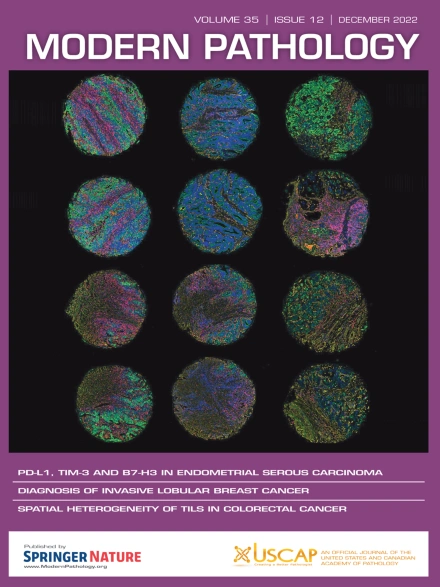Integrating Molecular Testing With Clinical Criteria and Histopathology Improves Diagnostic Precision in Immune-Mediated Liver Diseases
IF 7.1
1区 医学
Q1 PATHOLOGY
引用次数: 0
Abstract
Autoimmune hepatitis (AIH) and primary biliary cholangitis (PBC) are immune-mediated liver diseases (IMLDs) that are diagnosed by a combination of clinical, serologic, and histologic features. Diagnosis may be challenging, particularly when patients have mixed features of both AIH and PBC, a disease often called overlap syndrome (OS). In addition, many patients have refractory disease. We hypothesized that adding molecular testing to the current diagnostic criteria would provide an additional tool that could assist in correctly classifying patients. RNA was isolated from liver biopsies from patients with AIH (n = 16), PBC (n = 13), OS (n = 8), drug-induced/serology-negative AIH (AIH DI/Ser-neg, n = 6), or controls (n = 10). Gene expression was determined using an nCounter Sprint Profiler, and principal component analysis delineated distinct clusters for patients with an inflammatory profile due to AIH, PBC, and AIH DI/Ser-neg. Two patients with minimal histologic features of PBC clustered with the control group, and 2 patients with predominantly AIH and minimal PBC features clustered with the PBC group. A patient with OS who received treatment for both conditions showed no disease progression, whereas a patient with OS treated solely for AIH failed to respond. Conversely, one of the gene signatures from a patient diagnosed with PBC fell within the AIH group. This patient did not respond to treatment with ursodiol and ultimately required liver replacement. These findings suggest that the IMLD initially diagnosed in these patients may have been incorrectly classified. As expected, molecular analysis could not identify a distinct cluster for patients diagnosed with OS, and these had variable gene signatures that fell throughout the identified AIH or PBC groups. Cluster analysis was also able to distinguish patients with disease progression from non-progressors with mild disease who responded to treatment. In summary, gene expression analysis may assist in confirming the type of IMLD, especially when the diagnosis is unclear. Combining molecular testing with existing criteria could provide an additional diagnostic tool, improving patient care and response to treatment.
分子检测与临床标准和组织病理学的整合提高了免疫介导的肝脏疾病的诊断精度。
自身免疫性肝炎(AIH)和原发性胆管炎(PBC)是免疫介导的肝脏疾病(imld),通过临床、血清学和组织学特征的结合来诊断。诊断可能具有挑战性,特别是当患者同时具有AIH和PBC的混合特征时,这种疾病通常被称为重叠综合征(OS)。此外,许多患者有难治性疾病。我们假设,将分子检测添加到当前的诊断标准将提供一个额外的工具,可以帮助正确分类患者。从AIH (n=16)、PBC (n=13)、OS (n=8)、药物诱导/血清学阴性AIH (AIH- di /Ser-neg, n=6)或对照组(n=10)患者的肝脏活检中分离RNA。使用nCounter Sprint Profiler确定基因表达,主成分分析描绘了AIH, PBC和AIH- di /Ser-neg引起炎症的患者的不同簇。2例具有最小PBC组织学特征的患者与对照组聚集在一起,2例以AIH为主且最小PBC特征的患者与PBC组聚集在一起。接受两种情况治疗的OS患者没有出现疾病进展,而仅接受AIH治疗的OS患者则没有反应。相反,诊断为PBC的患者的一个基因特征属于AIH组。该患者对乌钠醇治疗无反应,最终需要肝脏置换。这些发现表明,在这些患者中最初诊断的IMLD可能被错误地分类。正如预期的那样,分子分析不能识别出诊断为OS的患者的独特集群,并且这些患者具有在已确定的AIH或PBC组中下降的可变基因特征。总之,基因表达分析可能有助于确定IMLD的类型,特别是在诊断不明确的情况下。将分子检测与现有标准相结合可以提供额外的诊断工具,改善患者的护理和治疗反应。
本文章由计算机程序翻译,如有差异,请以英文原文为准。
求助全文
约1分钟内获得全文
求助全文
来源期刊

Modern Pathology
医学-病理学
CiteScore
14.30
自引率
2.70%
发文量
174
审稿时长
18 days
期刊介绍:
Modern Pathology, an international journal under the ownership of The United States & Canadian Academy of Pathology (USCAP), serves as an authoritative platform for publishing top-tier clinical and translational research studies in pathology.
Original manuscripts are the primary focus of Modern Pathology, complemented by impactful editorials, reviews, and practice guidelines covering all facets of precision diagnostics in human pathology. The journal's scope includes advancements in molecular diagnostics and genomic classifications of diseases, breakthroughs in immune-oncology, computational science, applied bioinformatics, and digital pathology.
 求助内容:
求助内容: 应助结果提醒方式:
应助结果提醒方式:


